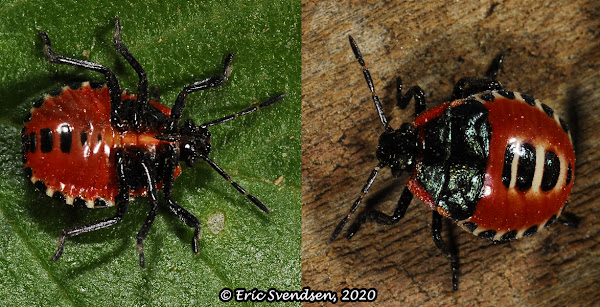The spined soldier stinkbug.
One of the reasons I enjoy taking photos of insects so much is because there is so much to learn. I have photos of insects that I have never identified; my downtime during covid has allowed me the opportunity to peruse through many of the images I had previously taken but not worked with. Today I found an interesting black and red insect I have only seen the one time and knew nothing about it. I found my blog of the day.
All insects can be classified as undergoing complete metamorphosis or incomplete metamorph0sis. Butterflies are an example of the former where there are two distinct stages; a larval form and an adult form. Beetles use a similar system with a larval form and an adult form. Incomplete metamorphosis involves a young insect growing up looking very much like its adult form; grasshoppers are a good example. True bugs also develop this way.
As an insect grows it has to shed its exoskeleton because the tough chitinous shell does not expand with the developing creature. Each stage is identified using the term instar. From the hatching of the egg to the first molt is the first instar. The stage from then to the next molt is called the second instar and so on. True bugs have five instars before becoming sexually mature adults. Sometimes the larvae look very much like the adults, other times not so much.
The above insect is a spined soldier stinkbug in the second instar stage. It looks vastly different from the adult form which is decidedly brown in colour. You have probably seen stinkbugs before and recognize them as plant pests. They are normally green or brown in colour and can emit a strong odor as a means of defense. The soldier stinkbugs have a similar defense mechanism but are not herbivorous; they are carnivores. Any insect with the term "soldier" in it refers to its predatory nature (soldier beetles, soldier ants, soldier flies are an exception). The adults (5th instar) have a pair of sharp spines on their "shoulders." They feed on the larvae of butterflies and beetles, most tend to be pests of economically important crops.
The left photo shows the underside of the insect. If you look at the head carefully you will see a sharp "beak-like" projection that extends past the first pair of legs. That is the biting mouthpart of the bug. All bugs have beak-like biting mouthparts and suck liquid food up it. Insectivorous bugs inject hydrolyzing protiens into a victum which kills it then liquifies its insides. The beak is then used to draw the contents into its stomach. Gross, but effective.
Thanks for reading. Ericspix Eric Svendsen
All insects can be classified as undergoing complete metamorphosis or incomplete metamorph0sis. Butterflies are an example of the former where there are two distinct stages; a larval form and an adult form. Beetles use a similar system with a larval form and an adult form. Incomplete metamorphosis involves a young insect growing up looking very much like its adult form; grasshoppers are a good example. True bugs also develop this way.
As an insect grows it has to shed its exoskeleton because the tough chitinous shell does not expand with the developing creature. Each stage is identified using the term instar. From the hatching of the egg to the first molt is the first instar. The stage from then to the next molt is called the second instar and so on. True bugs have five instars before becoming sexually mature adults. Sometimes the larvae look very much like the adults, other times not so much.
The above insect is a spined soldier stinkbug in the second instar stage. It looks vastly different from the adult form which is decidedly brown in colour. You have probably seen stinkbugs before and recognize them as plant pests. They are normally green or brown in colour and can emit a strong odor as a means of defense. The soldier stinkbugs have a similar defense mechanism but are not herbivorous; they are carnivores. Any insect with the term "soldier" in it refers to its predatory nature (soldier beetles, soldier ants, soldier flies are an exception). The adults (5th instar) have a pair of sharp spines on their "shoulders." They feed on the larvae of butterflies and beetles, most tend to be pests of economically important crops.
The left photo shows the underside of the insect. If you look at the head carefully you will see a sharp "beak-like" projection that extends past the first pair of legs. That is the biting mouthpart of the bug. All bugs have beak-like biting mouthparts and suck liquid food up it. Insectivorous bugs inject hydrolyzing protiens into a victum which kills it then liquifies its insides. The beak is then used to draw the contents into its stomach. Gross, but effective.
Thanks for reading. Ericspix Eric Svendsen




Comments
Post a Comment